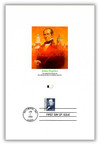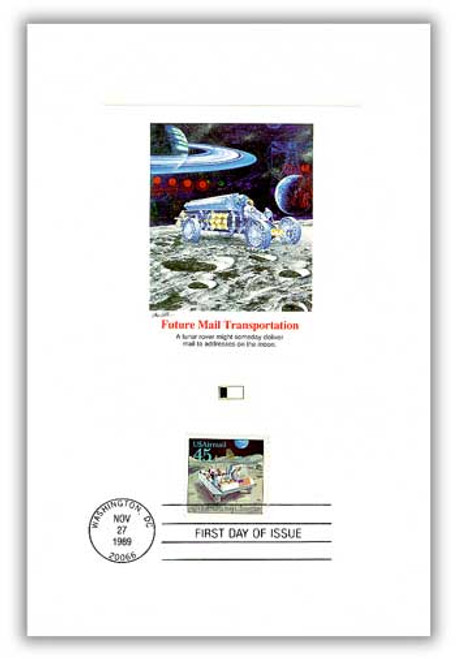
# 55757 - 1989 Johns Hopkins Proofcard
Often called the ultimate philatelic issue, the Fleetwood Proofcard is a distinctive commemorative with an elegantly embossed surface. Each Proofcard bears an original work of art complementing the theme of the stamp and created exclusively for Fleetwood by a leading American artist. Proofcards are often collected on their own, but would also make a beautiful addition to your existing stamp or cover collection.
Birth Of Johns Hopkins
Hopkins was named after his grandfather (also Johns Hopkins) who took his mother’s last name (Margaret Johns) as his first when she married Gerard Hopkins.
Hopkins was the second oldest of 11 children in a family of Quakers. After they emancipated their slaves in 1807, Hopkins worked on the farm, forcing him to take a break from his education. When he was 17 Hopkins went to Baltimore to work at his uncle’s grocery business. During the War of 1812, Hopkins’ uncle left him in charge of the shop, giving him the experience he needed to start his own business with Benjamin Moore.

The business was short-lived, leading Hopkins to then go into business with three of his brothers, creating Hopkins & Brothers Wholesalers in 1819. The Hopkins’ traveled the Shenandoah Valley in Conestoga wagons selling a variety of items, accepting corn whiskey as payment from rural families in lieu of money. When he returned to the city, he sold the whiskey as “Hopkins’ Best.” Hopkins also found significant financial success with smart investments, most notably with the Baltimore and Ohio Railroad (B&O). He later served as director of the railroad in 1847 and chairman of its Finance Committee in 1855. Hopkins also served as president of Merchants’ Bank and as the director of several other organizations. His financial successes were so great that he was able to retire in 1847 at the age of 52. But in addition to his business acumen, Hopkins was also extremely charitable. On more than one occasion he donated money to the city of Baltimore during financial crises and twice bailed the railroad out of debt.
Though he was a Maryland native, Hopkins was an avid abolitionist and supported the Union at the outbreak of the Civil War. His summer estate, Clifton, served as a meeting place for Union sympathizers during the war. He was also in frequent contact with President Lincoln, supporting his plans and offering the use of the use of the B&O Railroad for free.

After the war, Hopkins was distraught by the toll it had taken on Baltimore. He was also moved by the yellow fever and cholera epidemics that had killed hundreds in the city several years before. So in 1870, he prepared his will, which set aside $7 million for the creation of a free hospital, medical training colleges, as well as an orphanage and university for African Americans. (This was the largest philanthropic gift in America up to that time.) As Hopkins described it, “I have had many talents given to me and I feel they are in trust. I shall not bury them but give them to the lads who long for a wider education.”

After his death on December 24, 1873, Hopkins’ bequests were set into motion. Per his will, the Johns Hopkins Colored Children Orphan Asylum was to open first, in 1875. At the time, it was home to 24 children. The orphanage was later changed to a training school and later a home for crippled African American children and orphans. It eventually closed in 1924 and never reopened.

Johns Hopkins University was established in 1876, providing both higher education and scientific research. Two years later, the school began printing the Johns Hopkins Press, which is still produced today, making it the longest-running academic press in the country. The university is also frequently placed in the top 10 American colleges.

The Johns Hopkins Hospital and the Johns Hopkins School of Nursing opened in 1889 and the Johns Hopkins University School of Medicine opened in 1893. Together, they form one of the nations leading teaching hospitals and biomedical research facilities. A number of medical traditions were begun there, including rounds, residents and house staff. And the hospital developed several medical specialties including neurosurgery, cardiac surgery, pediatrics, and child psychiatry. Today, the hospital is often considered one of the best in the world and was ranked the best in America for 21 consecutive years.
Johns Hopkins graduates include a number of people featured on U.S. stamps, including Virginia Apgar, Rachel Carson, John Dewey, Woodrow Wilson, and Sidney Lanier.
Click here to view photos from the Johns Hopkins Medical Institutions.
Often called the ultimate philatelic issue, the Fleetwood Proofcard is a distinctive commemorative with an elegantly embossed surface. Each Proofcard bears an original work of art complementing the theme of the stamp and created exclusively for Fleetwood by a leading American artist. Proofcards are often collected on their own, but would also make a beautiful addition to your existing stamp or cover collection.
Birth Of Johns Hopkins
Hopkins was named after his grandfather (also Johns Hopkins) who took his mother’s last name (Margaret Johns) as his first when she married Gerard Hopkins.
Hopkins was the second oldest of 11 children in a family of Quakers. After they emancipated their slaves in 1807, Hopkins worked on the farm, forcing him to take a break from his education. When he was 17 Hopkins went to Baltimore to work at his uncle’s grocery business. During the War of 1812, Hopkins’ uncle left him in charge of the shop, giving him the experience he needed to start his own business with Benjamin Moore.

The business was short-lived, leading Hopkins to then go into business with three of his brothers, creating Hopkins & Brothers Wholesalers in 1819. The Hopkins’ traveled the Shenandoah Valley in Conestoga wagons selling a variety of items, accepting corn whiskey as payment from rural families in lieu of money. When he returned to the city, he sold the whiskey as “Hopkins’ Best.” Hopkins also found significant financial success with smart investments, most notably with the Baltimore and Ohio Railroad (B&O). He later served as director of the railroad in 1847 and chairman of its Finance Committee in 1855. Hopkins also served as president of Merchants’ Bank and as the director of several other organizations. His financial successes were so great that he was able to retire in 1847 at the age of 52. But in addition to his business acumen, Hopkins was also extremely charitable. On more than one occasion he donated money to the city of Baltimore during financial crises and twice bailed the railroad out of debt.
Though he was a Maryland native, Hopkins was an avid abolitionist and supported the Union at the outbreak of the Civil War. His summer estate, Clifton, served as a meeting place for Union sympathizers during the war. He was also in frequent contact with President Lincoln, supporting his plans and offering the use of the use of the B&O Railroad for free.

After the war, Hopkins was distraught by the toll it had taken on Baltimore. He was also moved by the yellow fever and cholera epidemics that had killed hundreds in the city several years before. So in 1870, he prepared his will, which set aside $7 million for the creation of a free hospital, medical training colleges, as well as an orphanage and university for African Americans. (This was the largest philanthropic gift in America up to that time.) As Hopkins described it, “I have had many talents given to me and I feel they are in trust. I shall not bury them but give them to the lads who long for a wider education.”

After his death on December 24, 1873, Hopkins’ bequests were set into motion. Per his will, the Johns Hopkins Colored Children Orphan Asylum was to open first, in 1875. At the time, it was home to 24 children. The orphanage was later changed to a training school and later a home for crippled African American children and orphans. It eventually closed in 1924 and never reopened.

Johns Hopkins University was established in 1876, providing both higher education and scientific research. Two years later, the school began printing the Johns Hopkins Press, which is still produced today, making it the longest-running academic press in the country. The university is also frequently placed in the top 10 American colleges.

The Johns Hopkins Hospital and the Johns Hopkins School of Nursing opened in 1889 and the Johns Hopkins University School of Medicine opened in 1893. Together, they form one of the nations leading teaching hospitals and biomedical research facilities. A number of medical traditions were begun there, including rounds, residents and house staff. And the hospital developed several medical specialties including neurosurgery, cardiac surgery, pediatrics, and child psychiatry. Today, the hospital is often considered one of the best in the world and was ranked the best in America for 21 consecutive years.
Johns Hopkins graduates include a number of people featured on U.S. stamps, including Virginia Apgar, Rachel Carson, John Dewey, Woodrow Wilson, and Sidney Lanier.
Click here to view photos from the Johns Hopkins Medical Institutions.












